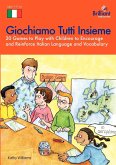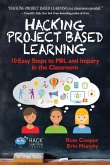- Gebundenes Buch
- Merkliste
- Auf die Merkliste
- Bewerten Bewerten
- Teilen
- Produkt teilen
- Produkterinnerung
- Produkterinnerung
This handbook is for elementary staff who work with English Language Learners, but who don’t have specialized training in English language acquisition.It provides a thorough picture of English Language Learners, and offers practical strategies for teaching.
Andere Kunden interessierten sich auch für
![Teaching English Language Learners Teaching English Language Learners]() Ann MorganTeaching English Language Learners38,99 €
Ann MorganTeaching English Language Learners38,99 €![Teaching Signature Thinking Teaching Signature Thinking]() John Lando CarterTeaching Signature Thinking168,99 €
John Lando CarterTeaching Signature Thinking168,99 €![Literature and Literacy for Young Children Literature and Literacy for Young Children]() Cyndi GiorgisLiterature and Literacy for Young Children185,99 €
Cyndi GiorgisLiterature and Literacy for Young Children185,99 €![Giochiamo Tutti Insieme - 20 Games to Play with Children to Encourage and Reinforce Italian Language and Vocabulary Giochiamo Tutti Insieme - 20 Games to Play with Children to Encourage and Reinforce Italian Language and Vocabulary]() K. WilliamsGiochiamo Tutti Insieme - 20 Games to Play with Children to Encourage and Reinforce Italian Language and Vocabulary20,99 €
K. WilliamsGiochiamo Tutti Insieme - 20 Games to Play with Children to Encourage and Reinforce Italian Language and Vocabulary20,99 €![Hacking Project Based Learning Hacking Project Based Learning]() Ross CooperHacking Project Based Learning23,99 €
Ross CooperHacking Project Based Learning23,99 €![Modern PBL Modern PBL]() Daniel JonesModern PBL31,99 €
Daniel JonesModern PBL31,99 €![Brilliant Activities for Speaking and Listening KS2 Brilliant Activities for Speaking and Listening KS2]() John FosterBrilliant Activities for Speaking and Listening KS221,99 €
John FosterBrilliant Activities for Speaking and Listening KS221,99 €-
-
-
This handbook is for elementary staff who work with English Language Learners, but who don’t have specialized training in English language acquisition.It provides a thorough picture of English Language Learners, and offers practical strategies for teaching.
Produktdetails
- Produktdetails
- Verlag: Rowman & Littlefield Publishers
- Seitenzahl: 124
- Erscheinungstermin: 15. März 2019
- Englisch
- Abmessung: 286mm x 221mm x 12mm
- Gewicht: 592g
- ISBN-13: 9781475843866
- ISBN-10: 1475843860
- Artikelnr.: 53928900
- Herstellerkennzeichnung
- Libri GmbH
- Europaallee 1
- 36244 Bad Hersfeld
- gpsr@libri.de
- Verlag: Rowman & Littlefield Publishers
- Seitenzahl: 124
- Erscheinungstermin: 15. März 2019
- Englisch
- Abmessung: 286mm x 221mm x 12mm
- Gewicht: 592g
- ISBN-13: 9781475843866
- ISBN-10: 1475843860
- Artikelnr.: 53928900
- Herstellerkennzeichnung
- Libri GmbH
- Europaallee 1
- 36244 Bad Hersfeld
- gpsr@libri.de
Ann Morgan is a long-time elementary and ESOL teacher, teacher trainer, and writer with experience at all levels of English Language Acquisition in K-8 and college. She holds multiple Masters degrees and has worked as a writer, editor and/or consultant for the state of Maryland, Oxford University Press, the Library of Congress, Discovery Education, and the National Institutes of Health.
Acknowledgments
Introduction
Acronym Soup and Other Terms
Chapter 1: Who are These Kids?
Countries and Backgrounds
Period of Adjustment
Grade Placement
The Silent Stage
An Adjustment Problem
Not an Adjustment Problem
Clothes
Realistic Expectations
Chapter 2: Home Comes to School
The Cultural Divide
General Information
Gender and Expectations
Socializing
Holidays
Resources
Chapter 3: Domains and Levels of English Language Learning
Language Domains
Listening
Speaking
Reading
Writing
Testing English Language Proficiency
Levels of English Language Proficiency
Level 1-2 Beginner
Level 3-4 Intermediate
Level 5-6 Advanced/Exited
Beginning Level Proficiency Goals
Intermediate Level Proficiency Goals
Advanced Level Proficiency Goals
Chapter 4: How to Talk to Your ELLs
Pace Yourself
Receptive Language
Productive Language
This is Tense. Keep it Simple.
Be an Active Active Speaker
More than Words
I Don't Get It
Chapter 5: Classroom Accommodations
What are Accommodations?
Typical Accommodations
Who is Part of the Accommodations Process?
When and Where do ESOL Students Use Accommodations?
Why Use Accommodations?
Chapter 6: Making the Everyday Puzzle Pieces Fit
The Basics
First Steps
Technology for the Unemployed
Let's Do Lunch-Book Talk
Overview
Before-Setting Up
During-Let's Eat
After-Clean Up
The Book Talk Ripple Effect
Chapter 7: Project Based Learning
Why PBL?
Collect Something
Write to Someone
Make Something
Play Something
Chapter 8: Strategies for Teaching Writing
Summaries
Fiction
Non-Fiction
General Organization
Dots Write
Point of View
The Kid Piece of the Writing Puzzle
Six Word Memoirs
OWL Purdue Online Writing Lab
Maryland Public Television
Chapter 9: What's the Problem?
ESOL and Special Needs
ESOL
Common Errors (Don't Worry)
Uncommon Errors (It's Time to Worry)
Chapter 10: What Teachers and Kids Say
Teachers
Input from Kids (with some grammar corrections)
Appendix A: Basic Skills Chart for Gardner's Multiple Intelligences
Appendix B: Suggested Readings for Book Talk
Appendix C: Project Based Learning (PBL) Activities
Appendix D: The Great Graph
Appendix E: Comparing Proficiency Levels over Time
Appendix F: Comparing Proficiency Scores within a Group
About the Author
Index
Introduction
Acronym Soup and Other Terms
Chapter 1: Who are These Kids?
Countries and Backgrounds
Period of Adjustment
Grade Placement
The Silent Stage
An Adjustment Problem
Not an Adjustment Problem
Clothes
Realistic Expectations
Chapter 2: Home Comes to School
The Cultural Divide
General Information
Gender and Expectations
Socializing
Holidays
Resources
Chapter 3: Domains and Levels of English Language Learning
Language Domains
Listening
Speaking
Reading
Writing
Testing English Language Proficiency
Levels of English Language Proficiency
Level 1-2 Beginner
Level 3-4 Intermediate
Level 5-6 Advanced/Exited
Beginning Level Proficiency Goals
Intermediate Level Proficiency Goals
Advanced Level Proficiency Goals
Chapter 4: How to Talk to Your ELLs
Pace Yourself
Receptive Language
Productive Language
This is Tense. Keep it Simple.
Be an Active Active Speaker
More than Words
I Don't Get It
Chapter 5: Classroom Accommodations
What are Accommodations?
Typical Accommodations
Who is Part of the Accommodations Process?
When and Where do ESOL Students Use Accommodations?
Why Use Accommodations?
Chapter 6: Making the Everyday Puzzle Pieces Fit
The Basics
First Steps
Technology for the Unemployed
Let's Do Lunch-Book Talk
Overview
Before-Setting Up
During-Let's Eat
After-Clean Up
The Book Talk Ripple Effect
Chapter 7: Project Based Learning
Why PBL?
Collect Something
Write to Someone
Make Something
Play Something
Chapter 8: Strategies for Teaching Writing
Summaries
Fiction
Non-Fiction
General Organization
Dots Write
Point of View
The Kid Piece of the Writing Puzzle
Six Word Memoirs
OWL Purdue Online Writing Lab
Maryland Public Television
Chapter 9: What's the Problem?
ESOL and Special Needs
ESOL
Common Errors (Don't Worry)
Uncommon Errors (It's Time to Worry)
Chapter 10: What Teachers and Kids Say
Teachers
Input from Kids (with some grammar corrections)
Appendix A: Basic Skills Chart for Gardner's Multiple Intelligences
Appendix B: Suggested Readings for Book Talk
Appendix C: Project Based Learning (PBL) Activities
Appendix D: The Great Graph
Appendix E: Comparing Proficiency Levels over Time
Appendix F: Comparing Proficiency Scores within a Group
About the Author
Index
Acknowledgments
Introduction
Acronym Soup and Other Terms
Chapter 1: Who are These Kids?
Countries and Backgrounds
Period of Adjustment
Grade Placement
The Silent Stage
An Adjustment Problem
Not an Adjustment Problem
Clothes
Realistic Expectations
Chapter 2: Home Comes to School
The Cultural Divide
General Information
Gender and Expectations
Socializing
Holidays
Resources
Chapter 3: Domains and Levels of English Language Learning
Language Domains
Listening
Speaking
Reading
Writing
Testing English Language Proficiency
Levels of English Language Proficiency
Level 1-2 Beginner
Level 3-4 Intermediate
Level 5-6 Advanced/Exited
Beginning Level Proficiency Goals
Intermediate Level Proficiency Goals
Advanced Level Proficiency Goals
Chapter 4: How to Talk to Your ELLs
Pace Yourself
Receptive Language
Productive Language
This is Tense. Keep it Simple.
Be an Active Active Speaker
More than Words
I Don't Get It
Chapter 5: Classroom Accommodations
What are Accommodations?
Typical Accommodations
Who is Part of the Accommodations Process?
When and Where do ESOL Students Use Accommodations?
Why Use Accommodations?
Chapter 6: Making the Everyday Puzzle Pieces Fit
The Basics
First Steps
Technology for the Unemployed
Let's Do Lunch-Book Talk
Overview
Before-Setting Up
During-Let's Eat
After-Clean Up
The Book Talk Ripple Effect
Chapter 7: Project Based Learning
Why PBL?
Collect Something
Write to Someone
Make Something
Play Something
Chapter 8: Strategies for Teaching Writing
Summaries
Fiction
Non-Fiction
General Organization
Dots Write
Point of View
The Kid Piece of the Writing Puzzle
Six Word Memoirs
OWL Purdue Online Writing Lab
Maryland Public Television
Chapter 9: What's the Problem?
ESOL and Special Needs
ESOL
Common Errors (Don't Worry)
Uncommon Errors (It's Time to Worry)
Chapter 10: What Teachers and Kids Say
Teachers
Input from Kids (with some grammar corrections)
Appendix A: Basic Skills Chart for Gardner's Multiple Intelligences
Appendix B: Suggested Readings for Book Talk
Appendix C: Project Based Learning (PBL) Activities
Appendix D: The Great Graph
Appendix E: Comparing Proficiency Levels over Time
Appendix F: Comparing Proficiency Scores within a Group
About the Author
Index
Introduction
Acronym Soup and Other Terms
Chapter 1: Who are These Kids?
Countries and Backgrounds
Period of Adjustment
Grade Placement
The Silent Stage
An Adjustment Problem
Not an Adjustment Problem
Clothes
Realistic Expectations
Chapter 2: Home Comes to School
The Cultural Divide
General Information
Gender and Expectations
Socializing
Holidays
Resources
Chapter 3: Domains and Levels of English Language Learning
Language Domains
Listening
Speaking
Reading
Writing
Testing English Language Proficiency
Levels of English Language Proficiency
Level 1-2 Beginner
Level 3-4 Intermediate
Level 5-6 Advanced/Exited
Beginning Level Proficiency Goals
Intermediate Level Proficiency Goals
Advanced Level Proficiency Goals
Chapter 4: How to Talk to Your ELLs
Pace Yourself
Receptive Language
Productive Language
This is Tense. Keep it Simple.
Be an Active Active Speaker
More than Words
I Don't Get It
Chapter 5: Classroom Accommodations
What are Accommodations?
Typical Accommodations
Who is Part of the Accommodations Process?
When and Where do ESOL Students Use Accommodations?
Why Use Accommodations?
Chapter 6: Making the Everyday Puzzle Pieces Fit
The Basics
First Steps
Technology for the Unemployed
Let's Do Lunch-Book Talk
Overview
Before-Setting Up
During-Let's Eat
After-Clean Up
The Book Talk Ripple Effect
Chapter 7: Project Based Learning
Why PBL?
Collect Something
Write to Someone
Make Something
Play Something
Chapter 8: Strategies for Teaching Writing
Summaries
Fiction
Non-Fiction
General Organization
Dots Write
Point of View
The Kid Piece of the Writing Puzzle
Six Word Memoirs
OWL Purdue Online Writing Lab
Maryland Public Television
Chapter 9: What's the Problem?
ESOL and Special Needs
ESOL
Common Errors (Don't Worry)
Uncommon Errors (It's Time to Worry)
Chapter 10: What Teachers and Kids Say
Teachers
Input from Kids (with some grammar corrections)
Appendix A: Basic Skills Chart for Gardner's Multiple Intelligences
Appendix B: Suggested Readings for Book Talk
Appendix C: Project Based Learning (PBL) Activities
Appendix D: The Great Graph
Appendix E: Comparing Proficiency Levels over Time
Appendix F: Comparing Proficiency Scores within a Group
About the Author
Index








